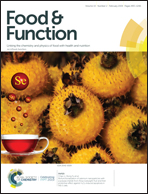Monascus yellow, red and orange pigments from red yeast rice ameliorate lipid metabolic disorders and gut microbiota dysbiosis in Wistar rats fed on a high-fat diet†
Abstract
This study aimed to compare the hypolipidaemic activities of different Monascus pigments (yellow, red and orange pigments) and elucidate their possible regulatory mechanisms on lipid and cholesterol metabolism in rats fed on a high-fat diet (HFD). Results showed that oral administrations of Monascus yellow, red and orange pigments can markedly alleviate the disturbance of lipid metabolism through ameliorating the serum lipid levels and suppressing hepatic lipid accumulation and steatosis. Meanwhile, the excretion of fecal cholesterol, triacylglycerols and bile acids was also promoted by the oral administrations of different Monascus pigments (MPs). Furthermore, Monascus pigment (MP) supplementation produced significant structural changes in the intestinal microbiota of HFD-fed rats, and modulated the relative abundance of functionally related microbial phylotypes compared with the HFD group in particular. Key phylotypes in response to the HFD and Monascus pigment (MP) intervention were found to strongly correlate with the lipid metabolism disorder associated parameters using Spearman's correlation coefficient. Some beneficial gut microbiota (such as Oscillibacter sp., Ruminococcus albus, Clostridium sp., etc.) were found to be negatively correlated with the serum and hepatic lipid indicator. Moreover, Monascus pigment (MP) treatments regulated the mRNA expression levels of the genes responsible for lipid and cholesterol metabolism. In general, different Monascus pigments (MPs) regulate the homeostasis of lipid and cholesterol metabolism through different regulatory pathways. These findings illustrated that not only Monascus yellow pigments, but also Monascus red and orange pigments have the potential to ameliorate lipid metabolic disorders, and therefore could be used as potential functional food ingredients for the prevention or treatment of hyperlipidemia and gut microbiota dysbiosis.



 Please wait while we load your content...
Please wait while we load your content...